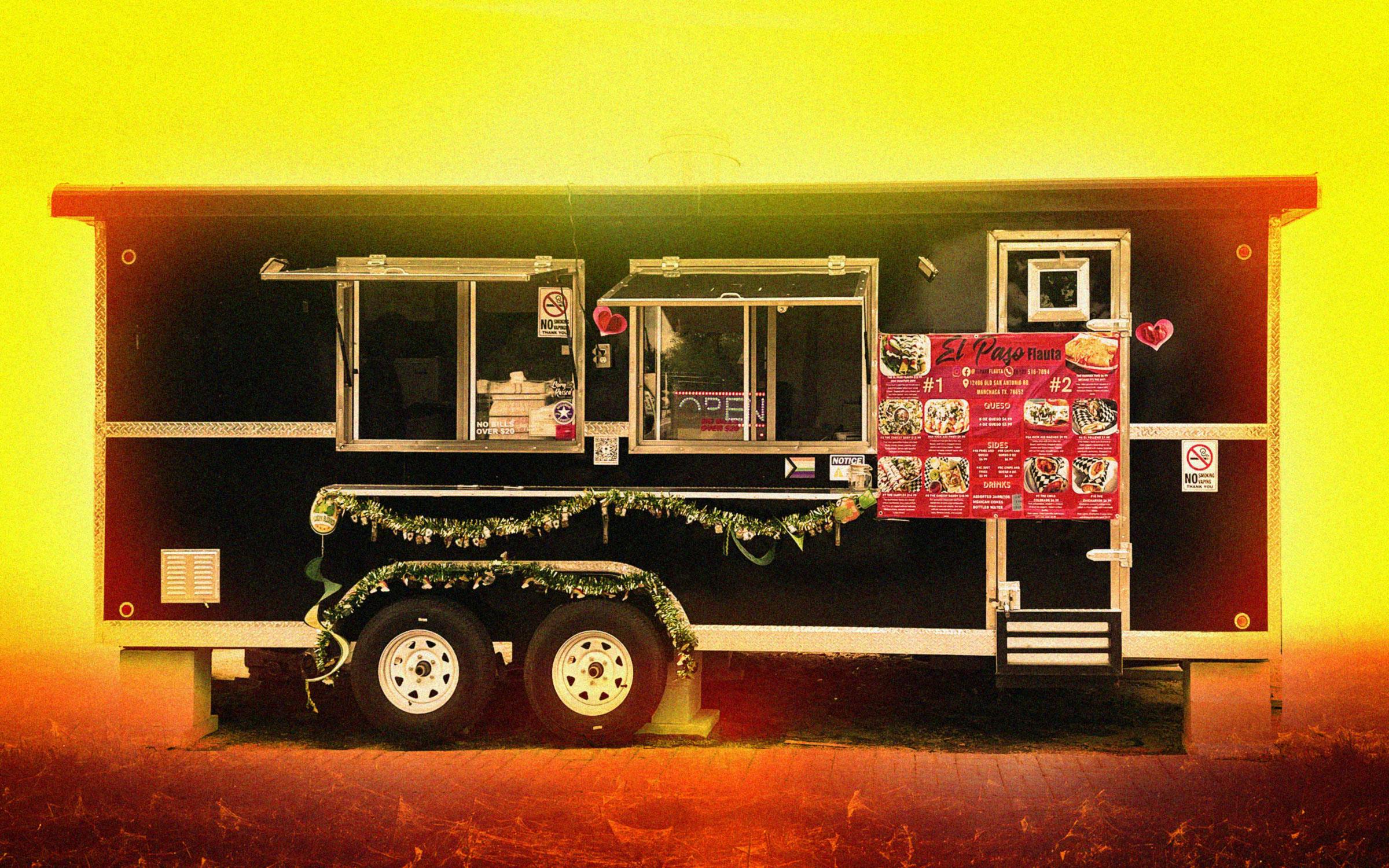As the first summer heat wave set in during early May, Lizzeth Martinez, co-owner of the Naco Mexican food truck, in San Antonio, saw business dip by double-digit percentages. As the season rolled on, the heat continued to negatively impact the business. “The news says it’s going to be hot, and people stay in,” Martinez explains with a nervous laughter that trails into an uncomfortable silence. By mid-August, Martinez says Naco’s sales had decreased by 30 percent. She shows me a text from a customer she describes as “a very good client.” The message reads: “haha, my restaurant spending has also been down because it’s so hot. I just want to do one trip to the grocery store instead of a few trips to various restaurants.” This sentiment is shared by many Texans as average temperatures climb and daily highs rocket pass the century mark. Taco truck owners are paying the price.
Stephanie Reyes, who co-owns El Paso Flauta, at the Tree House Park, in Austin, with her father, Art, says the truck’s sales have dropped by approximately 50 percent since the business’s best month, April. “Let me put it this way—we’ve been considering just closing for a month in the height of summer,” Reyes says. “We changed our hours based on when we usually have our best sales, but we also take into consideration how hot it gets in the trailer throughout the day.”
The customers who do visit El Paso Flauta are aware of the struggles of summer. They’re concerned for the Reyeses and their staff, often asking if there is air-conditioning in the trailer. There is, “but we’re running fryers and burners and a flattop all day,” Reyes says, noting that last year temperatures reached a high of 118 degrees Fahrenheit inside the trailer. Exposing workers to such heat isn’t just unfair; it’s also unsafe. Closing for a month would be reasonable—August 2023 was the hottest August in recorded meteorological history in Austin, Houston, and San Antonio, according to the San Antonio Express-News—but workers would then have to find employment elsewhere. In a food truck–obsessed city such as Austin, a worker might find a job at another food truck and decide to stay there.
Edgar Yepez, co-owner of Los Danzantes ATX, a Oaxacan-style food truck in South Austin, explains that sales have plummeted by 65 percent since the summer began. He’s had to lay off employees and cut hours as well. “This year, business has been like a roller coaster,” Yepez says. It’s also been educational. “We learned that we have to save a little more extra money for bad times like now to cover all the bills on time,” he adds.
Austin in August 2023 saw highs hovering near 105 degrees. In San Antonio last year, there were 29 days with temperatures climbing to at least 100 degrees. This doesn’t account for the heat index—what is sometimes called the real feel temperature. And it’s only getting hotter. By 2036, the state’s average surface temperature is expected to be 3 degrees hotter than the 1950–99 average, according to the Texas A&M University Office of the Texas State Climatologist.
This year’s been hot enough to drive food trucks to the point of financial stress, but it’s notably not as hot as last year. Still, the Alamo City’s Metropolitan Health District created a dashboard tracking heat-related illnesses in Bexar County, including heatstroke, though it does not measure heat-related deaths. That data is difficult to collect because there might not be information given to hospitals or evident in autopsies that indicates heat as a factor. But Dallas County Health and Human Services was able to confirm this year’s first heat-related death on August 15. The victim was 79 years old.
It’s not all fire and brimstone, though. El Tiger Taqueria and El Botanero Mariscos, both in the El Paso area, are seeing what they consider negligible changes. El Tiger Taqueria owner Jorge Ortiz says he’s seen a 10 percent to 15 percent decrease, adding that some El Pasoans are accustomed to heat waves, while others vacate the city during the summer’s hottest months. “Yes, they are used to it, but I definitely see how every year the city seems a bit emptier during May to July,” Ortiz says. El Botanero Mariscos has an advantage: specializing in aguachile, ceviche, and other cool seafood dishes. “Sales usually increase in the summer for us,” owner Abel Palacios says.
Austinites, though, aren’t acclimated to so many scorching days in a row. “I hope all this bad season finishes soon,” Yepez says.
Meanwhile, John Bates, owner of InterStellar BBQ and Yellow Bell Tacos, both in Austin, is keeping a cool head. Although he’s shortened his taco truck’s hours of operations, he’s patient. “It’s a summer heat thing,” he says. “In four to five weeks, when it cools down, we will return to normal hours.” Once the temperatures drop just a little bit in September (even if there’s still a high of 92 degrees), customers will start to come back.
For now, Bates remains undaunted. As he puts it: “I feel like it is part of the deal. The heat is inevitable.”
He’s right—there’s no getting around the temperature. But it’s not too bad if you wait outside for just a few minutes for your favorite tacos or Mexican dishes to go. You can eat them in your car.
But a brief stint at a picnic table isn’t unbearable. Last week, I scarfed down fresh churros with ice cream at Churro Co., in Austin, and tacos in Houston. I reckon you can too. It just might make the difference between a good day and a bad day for taco truck workers.

